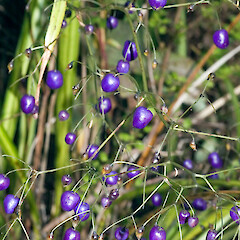Dianella nigra
Common name
turutu, New Zealand blueberry, inkberry
Synonyms
Dianella intermedia Endl. var norfolkensis F.B.H.Brown
Family
Xanthorrhoeaceae
Flora category
Vascular – Native
Endemic taxon
Yes
Endemic genus
No
Endemic family
No
Structural class
Herbs - Monocots
NVS code
The National Vegetation Survey (NVS) Databank is a physical archive and electronic databank containing records of over 94,000 vegetation survey plots - including data from over 19,000 permanent plots. NVS maintains a standard set of species code abbreviations that correspond to standard scientific plant names from the Ngä Tipu o Aotearoa - New Zealand Plants database.
DIANIG
Chromosome number
2n = 16
Current conservation status
The conservation status of all known New Zealand vascular plant taxa at the rank of species and below were reassessed in 2017 using the New Zealand Threat Classification System (NZTCS) – more information about this can be found on the NZTCS website. This report includes a statistical summary and brief notes on changes since 2012 and replaces all previous NZTCS lists for vascular plants.
Please note, threat classifications are often suggested by authors when publications fall between NZTCS assessment periods – an interim threat classification status has not been assessed by the NZTCS panel.
- Conservation status of New Zealand indigenous vascular plants, 2017 . 2018. Peter J. de Lange, Jeremy R. Rolfe, John W. Barkla, Shannel P. Courtney, Paul D. Champion, Leon R. Perrie, Sarah M. Beadel, Kerry A. Ford, Ilse Breitwieser, Ines Schönberger, Rowan Hindmarsh-Walls, Peter B. Heenan and Kate Ladley. Department of Conservation. Source: NZTCS and licensed by DOC for reuse under the Creative Commons Attribution 4.0 International licence.
2017 | Not Threatened
Previous conservation statuses
2012 | Not Threatened
2009 | Not Threatened
2004 | Not Threatened
Distribution
Endemic. North and South Islands
Habitat
coastal to montane (rarely subalpine) (1-1100 m a.s.l.). Colonising a wide variety of habitats from open coastal headlands, gumland scrub and less frequently peat bogs through to dense forest and subalpine scrub.
Wetland plant indicator status rating
Information derived from the revised national wetland plant list prepared to assist councils in delineating and monitoring wetlands (Clarkson et al., 2021 Manaaki Whenua – Landcare Research Contract Report LC3975 for Hawke’s Bay Regional Council). The national plant list categorises plants by the extent to which they are found in wetlands and not ‘drylands’. The indicator status ratings are OBL (obligate wetland), FACW (facultative wetland), FAC (facultative), FACU (facultative upland), and UPL (obligate upland). If you have suggestions for the Wetland Indicator Status Rating, please contact: [Enable JavaScript to view protected content]
UPL: Obligate Upland
Rarely is a hydrophyte, almost always in uplands (non-wetlands).
Detailed description
Loose tussock forming evergreen perennial herb, forming dense to open, diffuse clumps; rhizomes horizontally 150 mm (or more) long, strong and well developed. Leaves 250-800 x 12-18 mm, uniformly green to dark green, with distinct dark marginal bands 2-4 mm wide, discolorous, upright to strongly curved and distinctly drooping, more or less flat, lamina smooth and more or less glossy; margin and midrib of the leaf undersides smooth to scabrid, teeth often prominent; apex acute, leaf sheaths equitant, tightly clasping, surface light green to dark green with a reddish margin; apex acute to subacute. Inflorescence erect to spreading, up to 1 m long, exserted above the leaves; scape slender, arching, base asymmetric and up to 100 x 75 mm diameter; panicle 300-500 mm long, branches spreading, short, regularly spaced; cauline leaves subtending branches, leaf-like at the base but reducing in size and becoming bract-like distally; cymules 3-7-flowered; pedicels 10-17 mm long, slightly recurved, terete; bracteoles 1.0-1.2 x c.0.2 mm, narrow triangular, subtending pedicels caducous. Flowers nodding, 9-11 mm diameter, opening early morning, collapsing late afternoon, perianth segments strongly recurved at anthesis; sepals 4.4-4.5 x 1.6-1.7 mm, oblong, undersides olive-green flushed red-brown, upper surface paler, apex obtuse; petals 3.5-4.0 x 2.3-3.4 mm, obovate, white, midvein olive-green, apex obtuse to retuse; filaments 6, 1.3-1.4 mm long, white; anthers 1.3-1.4 x c.0.4 mm, yellow-brown, struma 1.2-1.4 x c.0.6 mm, obovate, yellow, minutely papillose; ovary 1.4-1.6 x 1.1-1.3 mm, green, more or less globular; style 1.7-2.1 mm long, white. Berry 8-20 x 7-10 mm, ovoid to oblong, grey-white and dull to strongly violet-blue and glossy, pericarp spongy. Seeds 1.8-2.1 x 2.3-3.0 mm, ovoid, black, shiny.
Similar taxa
Distinguished from D. haematica Heenan et de Lange and D. latissima Heenan et de Lange by open, loosely tussock forming habit, with dense to loose clumps, horizontally spreading rhizomes up to 150 mm long (sometimes more); light green to green leaf sheaths with reddish margins; green to dark green with darker marginal bands, curved, distinctly drooping leaves up to 0.8 m long and 18 mm wide with smooth or prominently scabrid leaf margins, acute leaf apex; inflorescences exposed from leaves, obovate (1.2-1.4 mm long) struma; and by the styles which are 1.7-2.1 mm long cf 1.4-1.5 mm long in D. latissima and 2.0-2.2 mm long in D. nigra. Dianella nigra may grow in wetlands
Flowering
November - December
Flower colours
Green, White
Fruiting
December - May
Life cycle
Fleshy berries are dispersed by frugivory (Thorsen et al., 2009).
Propagation technique
Easily grown from the division of whole plants and from fresh seed. Often available from garden centres though one populare form sold erroneously as D. intermedia is not that species or it would seem D. nigra s.s. Its exact status requires further investigation.
Etymology
dianella: Little Diana
nigra: Black
Attribution
Fact sheet prepared by P.J. de Lange for NZPCN (1 June 2013)
References and further reading
Thorsen, M. J.; Dickinson, K. J. M.; Seddon, P. J. 2009. Seed dispersal systems in the New Zealand flora. Perspectives in Plant Ecology, Evolution and Systematics 11: 285-309
NZPCN Fact Sheet citation
Please cite as: de Lange, P.J. (Year at time of access): Dianella nigra Fact Sheet (content continuously updated). New Zealand Plant Conservation Network. https://www.nzpcn.org.nz/flora/species/dianella-nigra/ (Date website was queried)

















